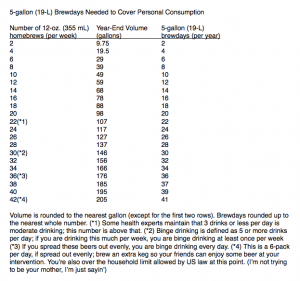
How often you would need to brew 5 gallons (19 L) of beer to cover your own personal level of beer consumption for a year. Click the chart to enlarge.
Around this time of year, people make resolutions — often to brew more — and perhaps even draw up a brewing plan for the coming year. If you’re wondering, “How often should I brew this year?,” there are a couple ways to look at it. The easiest answer is, of course, brew as often as possible — it’s your hobby, enjoy it to the fullest. A slightly nerdier way of looking at the question would involve planning your number of brew days to meet your anticipated beer needs.
Brewing generates beer, of course. At the end of the year, it’s possible to have brewed either too little beer or too much beer (if you accept that there is such a thing). Hitting the sweet spot between these two outcomes — having brewed exactly the right amount of beer — can be accomplished with a little planning and dedication. Here’s how you plan for it.
How Much Beer Do You Want?
To begin to figure out how often you should brew, you should make an estimate of how much homebrew you desire in 2014. One way to approach this is to think of an average week — how many beers do you drink and what percentage of them would you like to be homebrew (as opposed to commercial beers)? Take the number of homebrews per week times their volume (in ounces or mL) times 52 weeks per year and you’ll get the volume of homebrew you want per year (in ounces or mL).
Next, consider if there will be weeks when you’ll drink more than average (around the holidays, perhaps) or less than average (maybe you’re training for a road race or something). Add or subtract the volume of beer for the special occasions, if needed. Repeat these calculations for others in your household that drink your homebrew. Summing these numbers up will give you the volume of beer you estimate will be consumed in your household (in ounce or mL per year).
Unfortunately, not all of our homebrew is destined for personal consumption. Between homebrew club meetings, homebrew contests, giving beer to friends and family, donating beer to parties, etc., a substantial amount of beer can evade your stomach and end up in somebody else’s. So the next step is estimate the volume of beer not taking the tour of your digestive system (or the digestive system of someone else in your household). Add this to the yearly volume your household consumes, and if you’re lucky subtract that amount that you estimate other homebrewers will give to you. (If you swap homebrews with somebody, volume for volume, you don’t add or subtract anything. In that case, beer out equals beer in.)
Finally, decide on the minimum amount of beer you’d like to have on hand at any given time. If the amount is zero, and you spaced your brewdays out evenly, your next batch would be ready just as the keg blows. If, on the other hand, you decide that you’d always like to have some beer on hand, maybe one Corny keg (or two half-full Corny kegs or . . . you get the picture), then set an amount. Add this volume (in ounces or mL) to yield the total amount of beer you should brew this year. (Recall that in some places, there is a legal limit how much you can brew.)
How Much Do You Brew at a Time?
So now you know the volume of beer (in ounces or mL) that ideally you’d like to brew in 2014. Convert this to gallons (there are 128 fluid ounces in one (US) gallon) or liters, and divide by your usual batch size (in gallons or liters). This will tell you the number of times you should brew this year. The overall equation is:
where N is the number of brew days required and the various Vs are the volumes discussed above (use the same unit for each), with an added “other” to account for any other miscellaneous beer losses.
Once you’ve solved the equation, you can see how many brewdays you’ll need to schedule. If your free time is scarce, you can consider brewing larger batches of beer than you normally do (if your equipment allows it) or use high-gravity brewing to increase your output. If you expect to brew frequently, but find out that you will brew more beer than you desire, you can try scaling down your batch size. (Here’s one way for 5-gallon (19-L) all-grain brewers to scale down.)
Just to give you a quick look at what some numbers would look like, the chart at the top of this article shows how many 5-gallon (19-L) batches you would have to brew, just to cover your own personal consumption, based on average weekly beer consumption.

Speak Your Mind